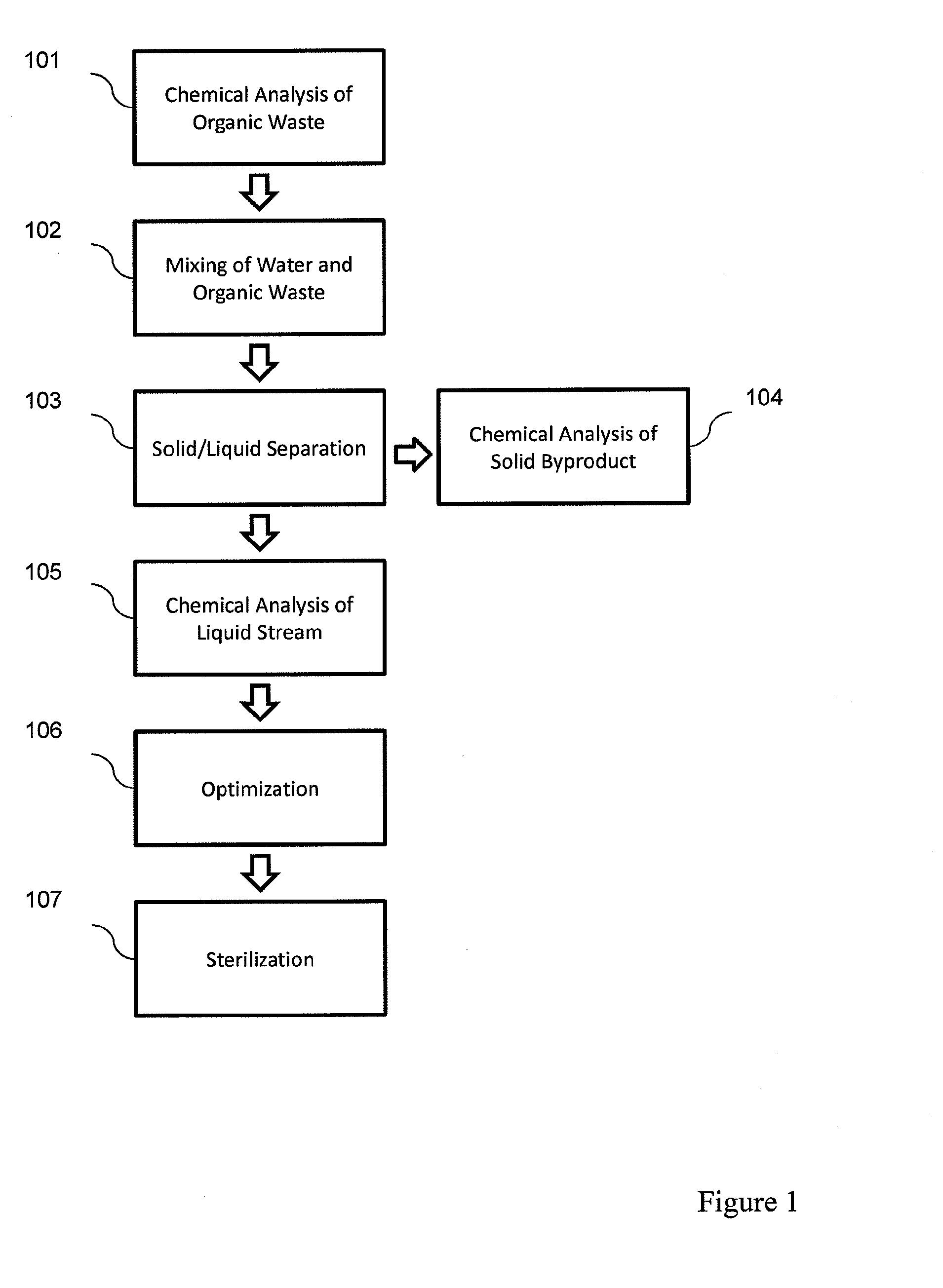Method for extracting nutrients from organic materials
- Summary
- Abstract
- Description
- Claims
- Application Information
AI Technical Summary
Benefits of technology
Problems solved by technology
Method used
Image
Examples
##ic example 1
PROPHETIC EXAMPLE 1
Cell Culture Broth / Media from Livestock Manure
[0075]First, a sample of the source livestock manure may be analyzed to determine in what concentration it should be combined with water. Following this analysis, the determination of the proper water to manure ratio can be achieved. Because nitrate, phosphates, glucose, and peptides are present at a certain ratio, the manure will be mixed with water based on the limiting nutrient. For example, the amount of phosphate present in the manure may be at an about 20 to 1 ratio compared to the solubility limit in water. This would mean the operator would combine about 5000 liters of water and about ¼ ton of cow manure in a 10000-liter batch reactor based on the limiting nutrient composition. Next, the mixture may be agitated for about 30 to 60 minutes at about 150 to 200 rpm under turbulent conditions. The reactor may be maintained at room temperature. Optionally, it may be heated up to about 100 degrees C. in order to aid i...
##ic example 2
PROPHETIC EXAMPLE 2
Cell Culture Broth / Media from Chicken Manure
[0076]First, a sample of the source chicken manure may be analyzed to determine in what concentration it should be combined with water. Following this analysis, the determination of the proper water to manure ratio can be achieved. Based on the fact that nitrate, phosphates, glucose, and peptides are present at a certain ratio, the manure will be mixed with water based on the limiting nutrient. For example, the amount of phosphate present in the manure may be at an about 20 to 1 ratio compared to the solubility limit in water. This would mean the operator would combine 10000 liters of water and ½ ton of chicken manure in a 15000-liter batch reactor based on the limiting nutrient composition. Next, the mixture may be agitated for about 30 to 60 minutes at about 150 to 200 rpm under turbulent conditions. The reactor may be maintained at room temperature. Optionally, it may be heated up to about 100 degrees C. in order to a...
##ic example 3
PROPHETIC EXAMPLE 3
Cell Culture Broth / Media from Swine Manure
[0077]First, a sample of the source swine manure may be analyzed to determine in what concentration it should be combined with water. Following this analysis, the determination of the proper water to manure ratio can be achieved. Based on the fact that nitrate, phosphates, glucose, and peptides are present at a certain ratio, the manure will be mixed with water based on the limiting nutrient. For example, the amount of phosphate present in the manure may be at an about 20 to 1 ratio compared to the solubility limit in water. This would mean the operator would combine 5000 liters of water and about ¼ ton of chicken manure in a 10000-liter batch reactor based on the limiting nutrient composition. Next, the mixture may be agitated for about 30 to 60 minutes at about 150 to 200 rpm under turbulent conditions. The reactor may be maintained at room temperature. Optionally, it may be heated up to about 100 degrees C. in order to ...
PUM
 Login to View More
Login to View More Abstract
Description
Claims
Application Information
 Login to View More
Login to View More - R&D
- Intellectual Property
- Life Sciences
- Materials
- Tech Scout
- Unparalleled Data Quality
- Higher Quality Content
- 60% Fewer Hallucinations
Browse by: Latest US Patents, China's latest patents, Technical Efficacy Thesaurus, Application Domain, Technology Topic, Popular Technical Reports.
© 2025 PatSnap. All rights reserved.Legal|Privacy policy|Modern Slavery Act Transparency Statement|Sitemap|About US| Contact US: help@patsnap.com


